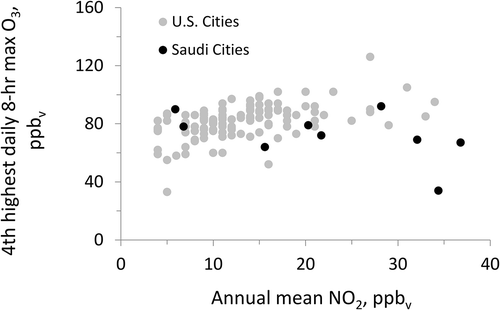Figures & data
Table 1. Site locations and properties
Figure 1. Location of monitoring stations. There are two stations in both Dammam and Alsodah for a total of nine sites (background map is from WikiCommons).
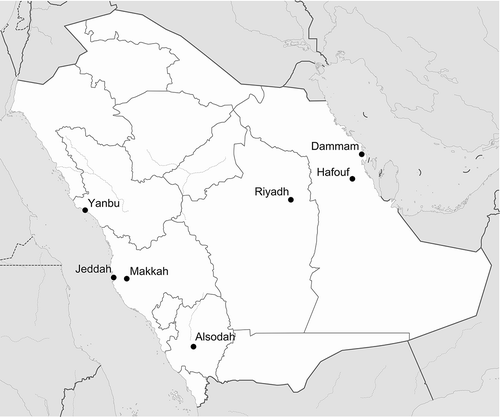
Table 2. Ambient air quality standards
Table 3. Annual median, mean, average daily 1-hr, and average daily 8-hr CO, NO2, and O3
Figure 2. The 1-hr (black) and 8-hr (gray) daily NO2 maxima are shown for each day of the year. The dotted line is the EPA 1-hr standard (100 ppbv). Not shown are the PME 1-hr (350 ppbv) and WHO 1-hr (106 ppbv) standards. See for site codes.
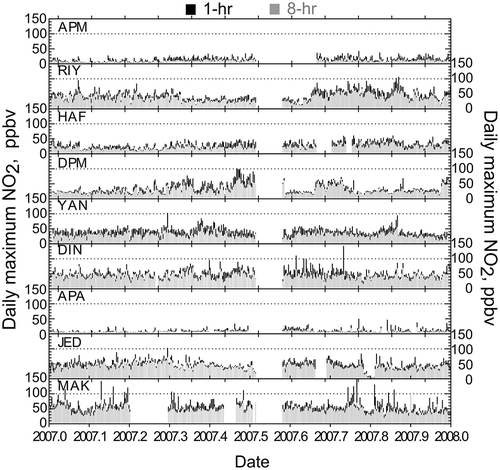
Figure 3. The 1-hr (black) and 8-hr (gray) daily O3 maxima are shown for each day of the year. The dashed line is the 8-hr WHO O3 standard (50 ppbv) and dotted line is the 8-hr EPA O3 standard (75 ppbv). Not shown are the PME 1-hr (80 ppbv) and 8-hr (120 ppbv) standards. See for site codes.
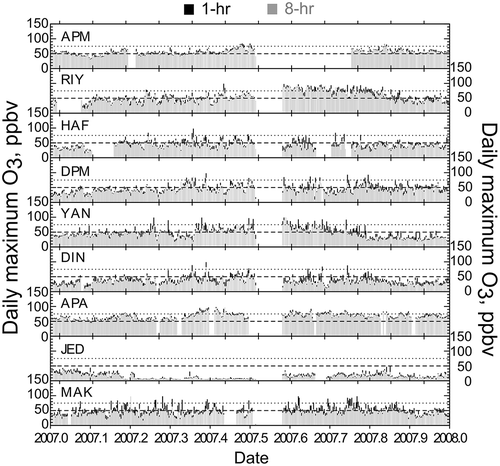
Figure 4. The 1-hr (black) and 8-hr (gray) daily CO maxima are shown for each day of the year. The dashed line is the EPA and WHO 8-hr standard (10 mg m−3), the dot-dash line is the WHO 1-hr standard (30 mg m−3), and the dotted line is the EPA 1-hr standard (40 mg m−3). Not shown are the PME 1-hr (9.3 m−3) and 8-hr (37 m−3) standards. See for site codes.

Figure 5. Boxplots of daily 1-hr maximum NO2, O3, and CO at all sites for the entire year of 2007. Dash-dot lines are site-wide means. The lower and upper bounds of the boxes give the first and third quartiles, respectively, the horizontal line within the box is the median, and the upper (lower) whiskers extend to 1.5 times the interquartile range or to the maximum (minimum) hourly value, whichever is smaller (larger). Outliers are excluded.
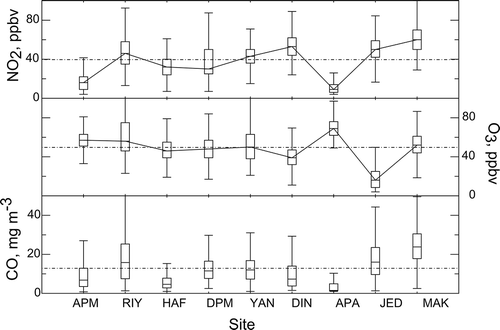
Figure 6. Daily maximum nitrogen dioxide by month and site. Black circles show daily 1-hr maximum NO2; gray squares show daily 8-hr maximum NO2. Error bars are standard deviations of the daily data. The dotted line is the EPA 1-hr NO2 standard (100 ppbv).
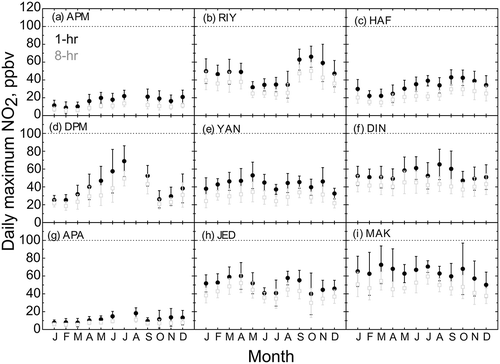
Figure 7. Daily maximum ozone by month and site. Black circles show daily 1-hr maximum O3; gray squares show daily 8-hr maximum O3. Error bars are standard deviations of the daily data. The dashed line is the WHO 8-hr O3 guideline (50 ppbv), and the dotted line is the EPA 8-hr O3 standard (75 ppbv).
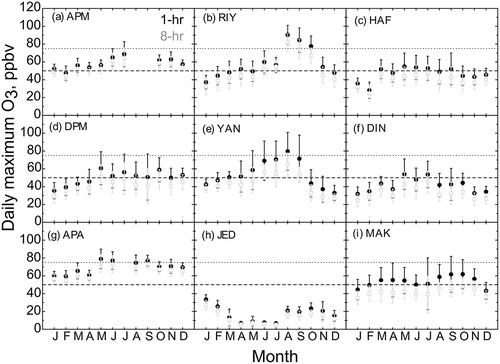
Figure 8. Daily maximum carbon monoxide by month and site. Black circles show daily 1-hr maximum CO; gray squares show daily 8-hr maximum CO. Error bars are standard deviations of the daily data. The dashed line is the WHO and EPA 8-hr CO guideline (10 mg m−3), and the dotted line is the EPA 1-hr CO standard (40 mg m−3).
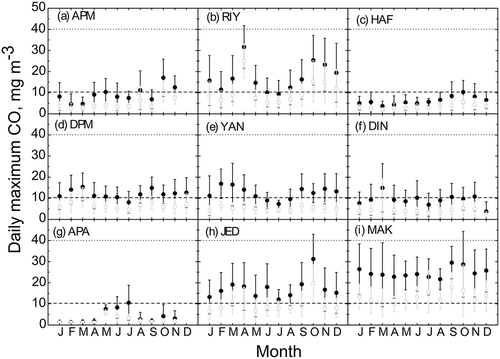
Table 4. Annual daily maxima and number of exceedances of NO2, O3, and CO
Figure 9. Annually averaged weekday and weekend diurnal cycles of NO2 by site. The circles show the weekday data. The weekday cycle is an average of Saturday, Sunday, Monday, Tuesday, and Wednesday. Error bars are the standard deviations of the daily means composing the weekday average. The solid (dashed) line shows the diurnal cycle for Thursday (Friday). See for description of site code names.
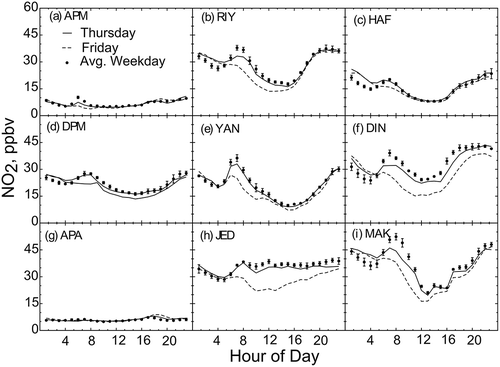
Figure 10. Annually averaged weekday and weekend diurnal cycles of O3 by site. The circles show the weekday data. The weekday cycle is an average of Saturday, Sunday, Monday, Tuesday, and Wednesday. Error bars are the standard deviations of the daily means composing the weekday average. The solid (dashed) line shows the diurnal cycle for Thursday (Friday). See for description of site code names.
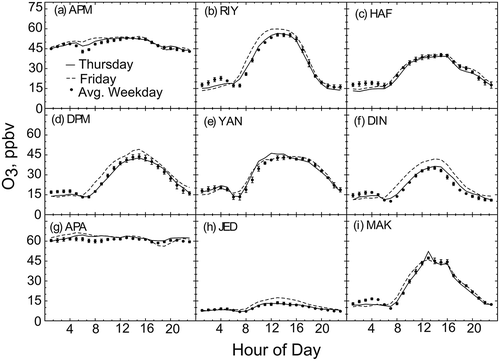
Figure 11. Annually averaged weekday and weekend diurnal cycles of CO by site. The circles show the weekday data. The weekday cycle is an average of Saturday, Sunday, Monday, Tuesday, and Wednesday. Error bars are the standard deviations of the daily means composing the weekday average. The solid (dashed) line shows the diurnal cycle for Thursday (Friday). See for description of site code names.
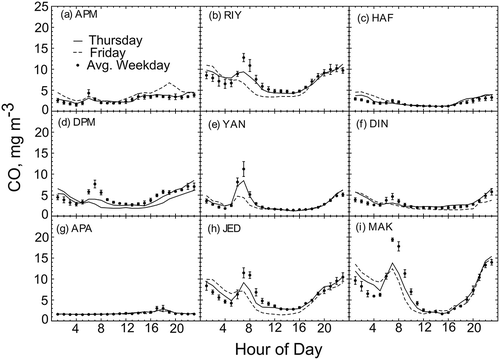
Figure 12. Average weekday diurnal cycles of NO2 and O3 by site. The weekday cycle is an average of Saturday, Sunday, Monday, Tuesday, and Wednesday. Error bars are the standard deviations of the daily means composing the weekday average. See for description of site code names.
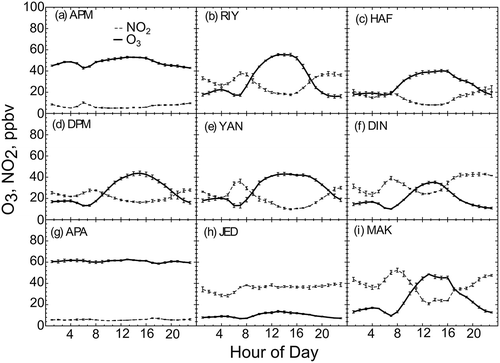
Figure 13. Diurnal cycles of NO2 during Ramadan and non-Ramadan “shoulder” periods. Shoulder periods are defined to be the 32-day intervals on either side of Ramadan. Error bars are standard errors. See for site codes.

Figure 14. Diurnal cycles of O3 during Ramadan and non-Ramadan “shoulder” periods. Shoulder periods are defined to be the 32-day intervals on either side of Ramadan. Error bars are standard errors. See for site codes.
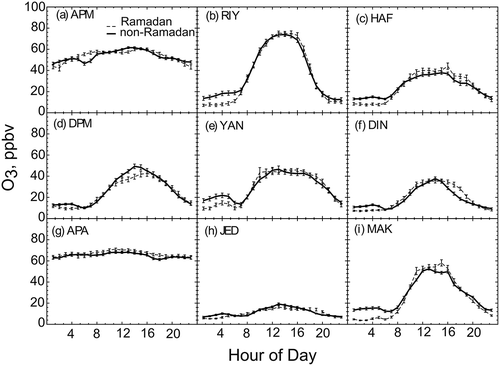
Figure 15. Diurnal cycles of CO during Ramadan and non-Ramadan “shoulder” periods. Shoulder periods are defined to be the 32-day intervals on either side of Ramadan. Error bars are standard errors. See for site codes.
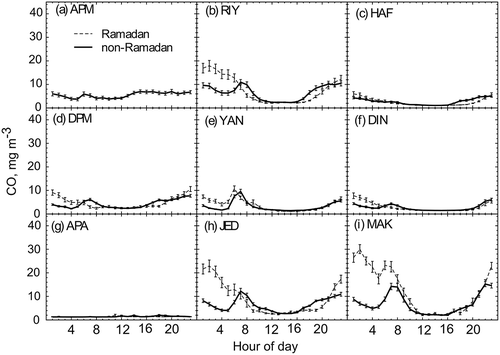
Table 5. Number of CO exceedances during Ramadan and non-Ramadan periods
Figure 16. Comparison of pollution levels between Saudi (black dots) and U.S. cities (gray dots). (a) O3, (b) NO2, and (c) CO. Data for U.S. cities are taken from EPA (Citation2012b).
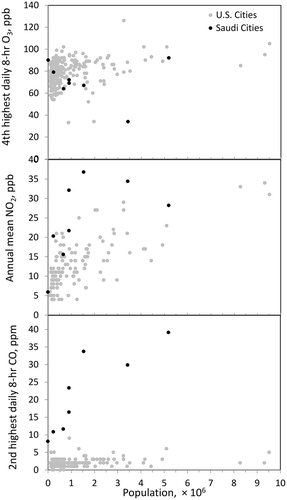
Figure 17. Correlation between O3 and NO2 levels at Saudi (black dots) and U.S. cities (gray dots). Data for U.S. cities are taken from EPA (Citation2012b).
